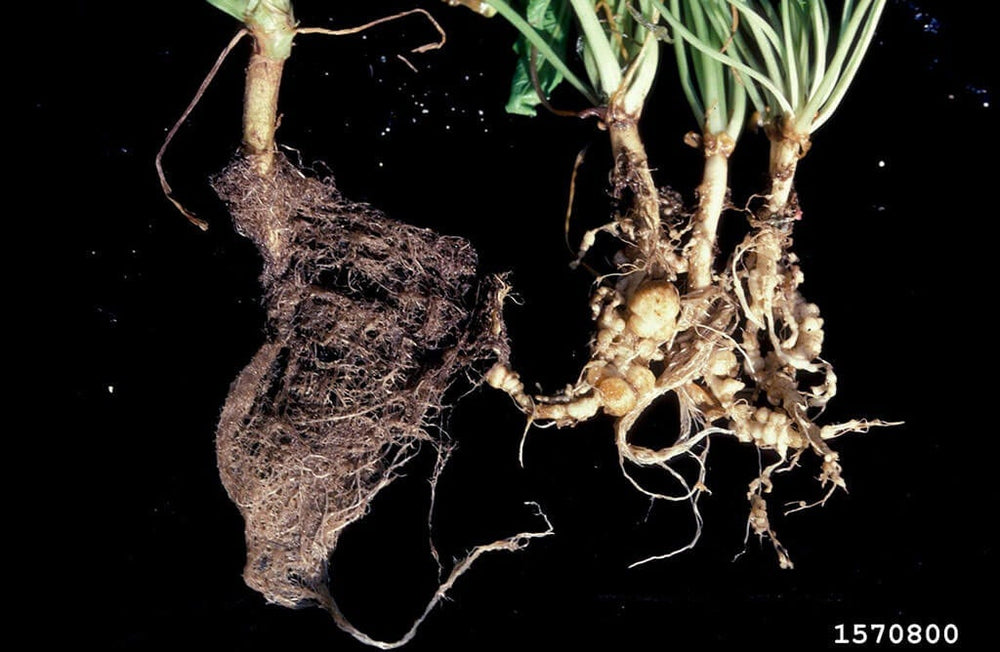 Healthy tomato roots (left) versus roots damaged by root-know nematodes (right). Photo credit: G. J. Holmes, Valent USA Corporation, Bugwood.org
Healthy tomato roots (left) versus roots damaged by root-know nematodes (right). Photo credit: G. J. Holmes, Valent USA Corporation, Bugwood.orgHow to Get Rid of Root-knot Nematodes
Even the tiniest creatures can cause big damage to your vegetable garden. Root-knot nematodes are microscopic garden pests that interfere with your plants' ability to absorb water. They can be tricky to ID, but once you do, there are many ways to outwit them. Here's how.
What are nematodes?
Nematodes are microscopic-sized creatures. There are both beneficial nematodes and harmful nematodes. In fact, only a few nematode types are plant pests, namely root-knot nematodes. Root-knot nematodes invade plant roots, where they then reproduce. Once inside a root, they release chemicals that cause cells to grow and form a gall, or unusual cluster of tissues, that makes it hard for the root to absorb water.
The southern root-knot nematode (Meliodognye incognita) causes serious damage to tomatoes, okra, beans, peas, eggplant, and peppers. As its name implies, this nematode is most common in warm climates. In northern areas, the northern root-knot nematode (M. halpa) can be a serious pest.
How do I know if I have root-knot nematodes?
The root galls interfere with water uptake and, as a result, plants may seem chronically thirsty. If heat stress is severe, infested plants wilt easily despite watering, and leaf tips may curl and turn brown. To confirm a diagnosis, dig up a struggling plant and look for knobby galls with stocky, thickened root sections—and know that nearby plants may also be affected.
How do I prevent and get rid of nematodes?
Gardening in soil naturally inhabited by root-knot nematodes requires strategic planning. Here are six ways to help combat them in your garden.
- Starve them. In many situations, you can suppress nematodes by alternating susceptible plants with resistant ones from year to year. If nematodes don't have susceptible plants to invade, their numbers will dwindle. With the Northern root-knot species, corn and grains are good choices to plant in the off years; with the Southern species, plant broccoli, cauliflower, mustard, and dwarf French marigolds.
- Use flowers. French marigolds can be planted as a cover crop to help get rid of nematodes. For maximum effectiveness, plant the whole area with French marigolds—with no other plants and allow them to flourish for the entire season. (Simply interplanting with marigolds is not enough.) Then, the next season, plant the crops you want to grow along with a few marigolds, calendula, and Miracle-Gro® dahlias, which help repel nematodes.
- Keep the soil biologically active. When you add compost, manure, and other microbially active materials to your garden soil, you increase the diversity of soil microbes. Some of these microbes may suppress nematodes. Soil amendments that contain chitin, such as seafood meal, eggshells, and shrimp hulls, may also be helpful.
- Water and mulch. If you grow susceptible plants in nematode-infested soil, be ready to provide extra water. Many plants can tolerate some nematodes and still produce if they are adequately supplied with water. Also use mulch to help retain moisture.
- Solarize in midsummer. In Southern regions, the yearly peak in nematode numbers often occurs in late summer, just when you're ready to replant vegetable beds for fall. Between spring and fall plantings, heat up badly infested soil beneath a sheet of clear plastic, securely tucked in at the edges. You'll have to skip the summer planting, but this solarization will provide good control for nematodes (and weed seeds!), provided the plastic remains in place for at least a month.
- Opt for containers. Consider growing your plants in containers filled with a premium quality potting mix such as Miracle-Gro® Performance Organics® All Purpose Container Mix. Place your containers where they won't sit directly on top of soil that's infested with nematodes.
- Grow nematode-resistant varieties. There are a lot of vegetable varieties that have been bred to be resistant to root-knot nematodes, so consider planting these if you suspect nematodes in your garden. On the plant tag or in the plant description, look for a capital "N"—that indicates the plant has a genetic resistance to nematodes. If you want to grow tomatoes, for example, choose from among these nematode-resistance Bonnie varieties:
AmeliaAtkinsonBeefmasterBetter BoyBetter BushBig Beef Bonnie OriginalBush Early GirlBush GoliathCelebrityLemon BoyPark's Whopper ImprovedPink GirlRed Beefsteak
Need more info and local pesticide recommendations? Contact your regional Extension agent. You can find the nearest Extension office through the Cooperative Extension System map.
Root-knot nematodes can be a major frustration. But once you've identified the problem, you can take action to outsmart them going forward through what—and how—you grow.







 Herbs
Herbs
 Vegetables
Vegetables
 Fruit
Fruit
 Flowers
Flowers
 Succulents
Succulents


